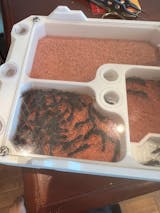Product Description
Species Overview
Harpegnathos venator, also known as the Jumping Ant or Professional Hunting Ant, is one of the most remarkable and visually striking species in the ant world. Native to South and Southeast Asia (India, Thailand, Vietnam, Malaysia), it is admired for its large size, keen vision, and predatory behavior.
Workers typically measure 13–16 mm, while queens can reach up to 18 mm, making them one of the largest ants kept in captivity. Their elongated heads, large compound eyes, and sharp mandibles allow them to perform precise hunting strikes on their prey — often by leaping forward in a sudden burst of speed, earning them the nickname “Jumping Ant.”
This species is particularly fascinating because of its unique reproductive system — if the queen dies, certain workers called gamergates can take over egg-laying duties, ensuring the colony’s survival without a traditional queen.
Natural Habitat & Behavior
In their natural environment, Harpegnathos venator colonies are typically found under fallen logs, in soft soil, or at the base of trees within humid tropical forests. They rely primarily on vision instead of pheromone trails to locate prey, scanning their surroundings with their large eyes before launching powerful, accurate leaps toward the target.
These ants are solitary hunters compared to many other species, making them fascinating to observe. Their behavior demonstrates a balance between precision hunting and complex social organization.
Comprehensive Keeping Guidelines
Nest Type: Use soil-based or plaster nests that maintain stable humidity. Include multiple chambers for brood development and a dry area for foraging.
Temperature: Maintain between 24–28°C (75–82°F). Avoid rapid or extreme temperature changes.
Humidity: Keep humidity around 70–80%. Sudden drops in moisture can affect larvae development.
Feeding & Nutrition
Primary Diet: Feed live or freshly killed insects such as fruit flies, crickets, and termites. These stimulate natural hunting instincts and promote healthy brood growth.
Supplemental Nutrition: Provide diluted honey or sugar water once per week for carbohydrates.
Feeding Schedule: Feed small portions every 2–3 days. Remove uneaten prey promptly to prevent mold growth.
Advanced Care Considerations
Reproductive Flexibility: If the queen dies, certain workers (gamergates) can become reproductively active — a unique trait among ants.
Environmental Sensitivity: This species is highly sensitive to vibration, light, and noise. Keep the colony in a quiet, stable environment away from frequent disturbance.
Acclimation: A small amount of worker loss during shipping is normal. Colonies usually stabilize within 7–10 days under consistent conditions.
Our Guarantee
- ✅ 100% Healthy, Fertilized Queens
- ✅ Free Replacement or Refund if the Queen Arrives Deceased
- ✅ Ethically Sourced and Legally Exported Colonies
Responsible Keeping Notice
Harpegnathos venator is recommended only for experienced ant keepers, due to its specialized care requirements and predatory behavior. Always follow local wildlife regulations and never release non-native species into the wild.
SEO Keywords
Harpegnathos venator, Jumping Ant, Hunting Ant Colony, Predator Ant, Vision-Based Ant, Southeast Asian Ants, Advanced Ant Keeping, Exotic Live Ants, AntNook.






